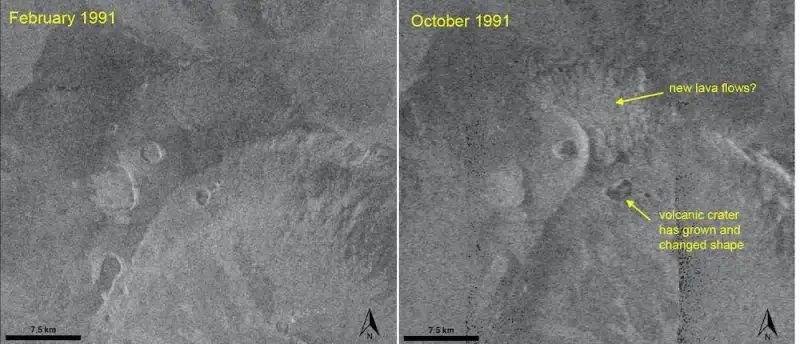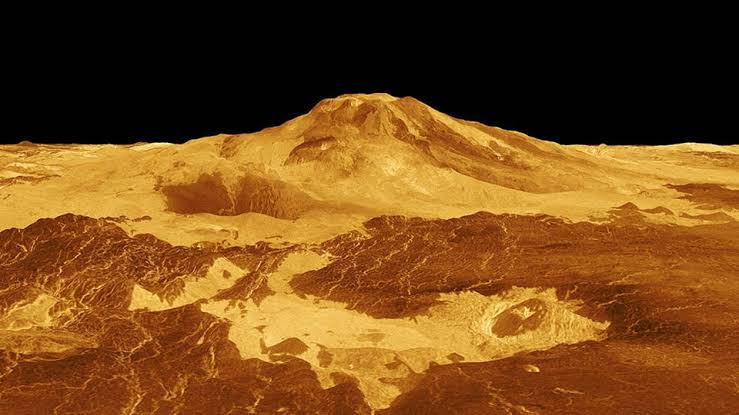Venus is often referred to as earth’s twin due to its size, mass, density and internal heat through the decay of radioactive elements, similar to the Earth. We had never seen any signs of active volcanic eruptions on Venus until now.
Recent scientific findings have provided compelling evidence of volcanic activity on Venus, adding to our understanding of the planet’s geology and history. The discovery is particularly significant given that Venus, as Earth’s closest planetary neighbour, has long been a subject of interest for scientists studying the origin and evolution of the solar system.
Studying venus is no easy task. At the surface of Venus is a dense and opaque atmosphere, which includes a continuous cloud layer at an altitude of 45-65km. This layer blocks most wavelengths of radiation, making it difficult to obtain a clear view of the planet’s surface.
The only effective method of obtaining a detailed view of the ground is through the use of radar directed downwards from an orbiting spacecraft. This allows scientists to generate high-resolution images of the surface, revealing its geological features and providing valuable insights into the planet’s history and evolution.
How Was This Discovered?
From 1990-1994, NASA’s Magellan probe used radar to map Venus’ surface, revealing that over 80% of it is covered by lava flows. Scientists studied the radar images taken from NASA’s Magellan taken between 1990-1992 and discovered that the area on Venus, Alta Regia, which houses two of the largest volcanoes on the planet, Ozza Mons and Maat Mons, changed shape between two images taken eight months apart.
Comparing the two observations of the volcanic vent on Venus was challenging due to their opposite viewing angles and different perspectives, which was further complicated by the low resolution of the three-decade-old data. Robert Herrick, a research professor at the University of Alaska Fairbanks and member of the VERITAS science team, who led the search, with a colleague utilized computer modelling to better understand the observed changes in the volcanic vent on venus by exploring various geological scenarios, including landslides.
Their analysis showed that only an eruption could account for the observed changes, leading them to conclude that Venus is still volcanically active. Thus a conclusion was reached that this change in shape was only possible due to ongoing volcanic activity on Venus.

Venus And Its Volcanism:
With over 1600 major volcanic features recorded, Venus has more volcanoes than any other planet in the solar system. The number of smaller volcanoes may be even more staggering, with some estimates placing it in the hundreds of thousands or even millions. These volcanoes come in a variety of shapes and sizes, with large shields and smaller shield volcanoes being the most common.
But there are also many complex features, unusual constructs, and large flow features, making Venus’s volcanic landscape a true marvel of the solar system. Venus’s volcanic activity is unique in that it primarily involves fluid lava flows.
Why This Discovery Matters?
This discovery of active volcanos on Venus is important because it confirms the presence of an ongoing geological activity on Venus. This discovery suggests that the planet is still evolving, and helps to shed light on the factors that have shaped its surface over time. It also adds to our understanding of how volcanism on other planets operates. Study of volcanic activity on other plants also helps us understand how the interior of a planet change has an impact on the shape of its crust. drive its revolution and affect its habitability.
Future Missions To Venus:
There are various future missions lined up for the future that are highly anticipated and aim to provide new insights about the planet’s geology and atmosphere.
NASA’s VERITAS (Venus Emissivity, Radio Science, InSAR, Topography, and Spectroscopy) spacecraft is set to launch in 2028. It will use advanced radar and imaging technology to map Venus’s surface in unprecedented detail, providing new insights into the planet’s geology and history.
The European Space Agency’s EnVision mission, launching in 2032, will also use radar and other instruments to study Venus’s surface and atmosphere, with a particular focus on understanding the planet’s geological processes and the evolution of its atmosphere.
Additionally, there are proposals for future Venus missions including orbiters, landers, and balloon-based platforms.
Conclusion:
This discovery of an active volcano on Venus opens up new avenues of research for scientists. With advancements in technology and a renewed interest in Venus, future missions are set to provide us with a better understanding of the planet’s geology and atmosphere.
Studying Venus’s volcanism will allow us to better comprehend the unique geological processes that have shaped our neighbouring planet, and potentially even give us insights into similar processes on Earth. As we continue to explore and study Venus, we are sure to uncover more exciting discoveries and expand our knowledge of our solar system and the universe beyond.
